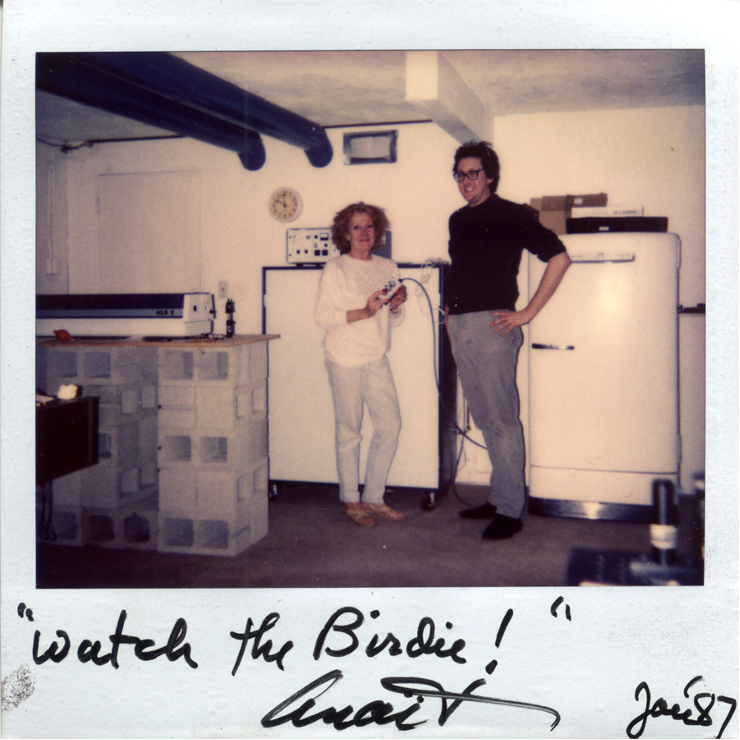
“You don’t know who you’re talking to, lady.” "You don’t know who you’re talking to, mister,” were fighting words between two holographic pioneers, Holicon president Max Epstein and holographic artist Anait Arutunoff Stephens. Ironically, decades later, very few people remember either of their names. But Epstein and especially artist extraordinaire Anait (as she preferred to be called) created compelling and pioneering holographic works that are largely unknown today.

At a recent Visual Effects Society (VES) event with the Hollywood chapter, I had the pleasure of moderating a panel on Holographic display technologies with Jon Karafin, CEO from Light Field Lab, Dr. Daniel Smalley, Associate Professor with BYU and Thaisa Yamamura, Head of Business Development from SONY. In my opening remarks, I related my past experiences with holography, including my early encounters, in the late 1980s, with Anait.
The shouting match between Anait and Max Epstein was over the fee that Holicon would charge her for the daily rental of the lab. Ed Wesly, the sole proprietor at The Studio of Ed Wesly & Sons in Chicago, explained that he was the unwitting instigator in the dispute by quoting Anait $500 per day to rent the pulsed Ruby laser and equipment at the Holicon lab. Ed had yet to run it past the team at Holicon before daring to open his mouth but when they all got on the phone, Max was steadfast at a kilobuck a day and would not budge, nor would Anaït.
Ed Wesly called up Anait the following week to offer his apologies for getting her involved, but she was completely all right with the situation as she had decided to purchase her own pulsed Ruby laser system from Lumonics, the company I was working for at the time. The rental rate dispute had tipped her over the edge to buy one of her own systems for $54,365 in 1987. This is how I first came to meet Anaït.

Despite the price, Anait -whose Home + Studio was in the pricey community of Montecito, California- near the Pacific Ocean-could afford the Lumonics HLS-2 pulsed Ruby laser system. Legend has it that her father invented an electric motor that could work underwater and her husband invented underwater oil drilling bits. So although one could see drilling rigs out in the Pacific from their backyard, they were also seeing dollar signs pumping out of them. Anait was an inventor in her own right, patenting a device she called “Stir Crazy”, a battery powered spoon for mixing puddings in the pot on the stove.
Anait was a very smart and creative technical artist. When I met her and we installed the system, I was amazed at the scientific approach she took to her research and art. In contrast to her family's work in the oil industry, the holographic art she was creating at the time reflected the effects of mankind on the environment. I remember a physical reconstruction of a riverbed with trash added and dead fish floating and the large format holograms she generated that reflected these images and their emotion in 3D space. It was beautiful and poignant work. I always enjoyed my time with Anait.
I visited her several times for general maintenance support and realignment of her pulsed Ruby laser to maximize the image quality and brightness. I would usually be finished in 30 minutes but would stay for 3-4 hours as she guided me through her work and art.
If you are not familiar with Anait's holographic work, check out Al Razutis’s Wavefront archives or this short YouTube excerpt from an extended video. Anait signed her correspondence with AWHOIH, (Artist Working Hands-On In Holography), and she really did the work herself. She was definitely a pioneer in the field, and created some impressive pieces.
Pictured below is her "Water Lilies After Monet '' mentioned in the YouTube video and was installed at the 4th International Symposium on Display Holography at Lake Forest College in 1991.

Unfortunately, Anait was diagnosed with cancer later in life, and she donated the pulsed Ruby laser system and optical table to Lake Forest College, where Ed Wesly installed it in a lab in the basement for Dr. Tung Jeong. Later christened the Anait Laboratory for Pulsed Laser Holography, this lab remained in use until 2008. After that the lab was reassigned and today the system resides back with Ed Wesly. It still works and is a part of his holographic collection.
Final works in collaboration with Hans Bjelkhagen, Lake Forest College, Il

"The Flag (1996) by Anait and Hans Bjelkhagen -- full color silver halide hologram on glass signed by the artist, size: 8” x 10” (20 x 25 cm)
"The color hologram here was recorded at Lake Forest College, Illinois, USA, in co-operation with Hans Bjelkhagen. A pseudoscopic color sculpture of the flag, with the stars falling off the flag, was created by Anait. This art piece for the hologram was recorded using three (RGB) lasers on a Russian Slavich panchromatic PFG-03c silver-halide emulsion. During the recording, the emulsion side of the plate was facing the reference beam and not the object. When the hologram plate is flipped-around when on display, the image appears in front of the plate with a large field of view.
Anait had been using pseudoscopic holographic imagery for her earlier reflection holograms and wanted to use this technique for her first color hologram. She explained that since it is difficult to show this effect by photography, video, etc., You have to see it to believe (in) it."
Al Rezutis, also assembled a collection called “ANAIT - Dancing with Light Waves” that shows off an excellent collection of Holograms and her early art which all revolved around 3D from sculpture to light projection and eventually Holography.
The pioneering work in holographic art of ANAIT ARUTUNOFF STEPHENS (1922-1998) or 'ANAIT', has gone largely unappreciated until now. With a personal knowledge of her work and the artist, Al Razutis has added videos to her legacy and the West-Coast Artists in Light project in the form of several analog (NTSC) videos which are low resolution by today's standards but are rare finds of historical work. View the 90 sec. clip of rare multiplex holograms by ANAIT on the Youtube channel XAR3D
Anait was an inspiration to me as a creative technologist and pushed me closer to my vision of 3D art. As display technology continues to evolve, the holographic experience will continue to always capture my attention but artists like Anait will always capture my imagination.
Reference:
Ed Wesly, Sole Proprietor at The Studio of E. Wesly & Sons.
XAR3D, Al Rezutis, “ANAIT - Dancing with Light Waves”
Alchemists.com - In Memoriam, ANAIT (1922 - 1998)